The Sleeping Beauty
Introduction
"The Sleeping Beauty" is a classic fairy tale that has been adapted and retold in various forms across different cultures and media. The story's origins can be traced back to the narrative traditions of medieval Europe, and it has since evolved into a beloved tale with numerous interpretations. This article delves into the historical context, literary analysis, and cultural impact of "The Sleeping Beauty," providing a comprehensive exploration of its various facets.
Historical Context
Origins
The earliest known version of "The Sleeping Beauty" can be found in the narrative collection "Perceforest," a medieval prose romance written in the 14th century. This version, however, differs significantly from the tale we recognize today. The story gained widespread popularity with the publication of Charles Perrault's "La Belle au bois dormant" in 1697, which was later included in his collection "Histoires ou contes du temps passé." Perrault's version introduced many of the elements that have become synonymous with the tale, such as the spindle, the curse, and the long sleep.
Evolution
The tale was further popularized by the Brothers Grimm in their 1812 collection "Grimm's Fairy Tales," where it was titled "Dornröschen" or "Little Briar Rose." The Grimm version retained many of Perrault's elements but added a more Germanic flavor to the narrative. Over time, "The Sleeping Beauty" has been adapted into various forms, including ballet, opera, and film, each adding its unique interpretation and nuances to the story.
Plot Summary
Perrault's Version
In Charles Perrault's version, a king and queen finally have a daughter after many years of longing. They invite seven fairies to the christening, but an eighth fairy, who was not invited, curses the princess to die by pricking her finger on a spindle. One of the good fairies mitigates the curse, decreeing that the princess will instead fall into a deep sleep for 100 years, only to be awakened by a prince's kiss. The curse comes true, and the princess falls asleep. After a century, a prince discovers the castle, kisses the princess, and awakens her. They marry and live happily ever after.
Grimm's Version
In the Grimm Brothers' version, the story is similar but includes additional elements such as the hedge of thorns that grows around the castle, protecting the sleeping princess. The prince must brave these thorns to reach the princess and awaken her with a kiss. The Grimm version also includes a more detailed account of the celebrations and the eventual marriage of the prince and princess.
Literary Analysis
Themes
"The Sleeping Beauty" explores several recurring themes, including the passage of time, the inevitability of fate, and the power of true love. The long sleep symbolizes a period of transformation and renewal, while the prince's kiss represents the awakening of potential and the triumph of love over adversity.
Symbolism
The spindle and the curse are rich in symbolic meaning. The spindle, an everyday object, becomes an instrument of fate, highlighting the theme of destiny. The curse, often seen as a metaphor for puberty or coming of age, marks the transition from childhood to adulthood. The hedge of thorns symbolizes obstacles and challenges that must be overcome to achieve one's goals.
Archetypes
The characters in "The Sleeping Beauty" embody classic archetypes found in many fairy tales. The princess represents innocence and purity, the prince symbolizes heroism and bravery, and the evil fairy embodies malevolence and envy. These archetypes contribute to the story's enduring appeal and its ability to resonate with audiences across generations.
Cultural Impact
Ballet
One of the most famous adaptations of "The Sleeping Beauty" is the ballet composed by Pyotr Ilyich Tchaikovsky in 1889. The ballet, choreographed by Marius Petipa, premiered at the Mariinsky Theatre in St. Petersburg, Russia. Tchaikovsky's score and Petipa's choreography have made this ballet a staple of classical ballet repertoire, celebrated for its musical and artistic excellence.


Film
"The Sleeping Beauty" has been adapted into numerous films, with Walt Disney's 1959 animated feature being one of the most iconic. Disney's version introduced the character of Maleficent, the evil fairy, who has since become a cultural icon in her own right. The film's animation, music, and character design have left a lasting legacy, influencing subsequent adaptations and interpretations of the tale.
Literature
The tale has inspired countless literary works, from retellings and reinterpretations to scholarly analyses. Authors such as Anne Rice and Neil Gaiman have offered their unique takes on the story, exploring its darker and more complex themes. "The Sleeping Beauty" continues to be a rich source of inspiration for writers and scholars alike.
See Also
References
- Perrault, Charles. "Histoires ou contes du temps passé." 1697.
- Grimm, Jacob and Wilhelm. "Grimm's Fairy Tales." 1812.
- Tchaikovsky, Pyotr Ilyich. "The Sleeping Beauty." 1889.
